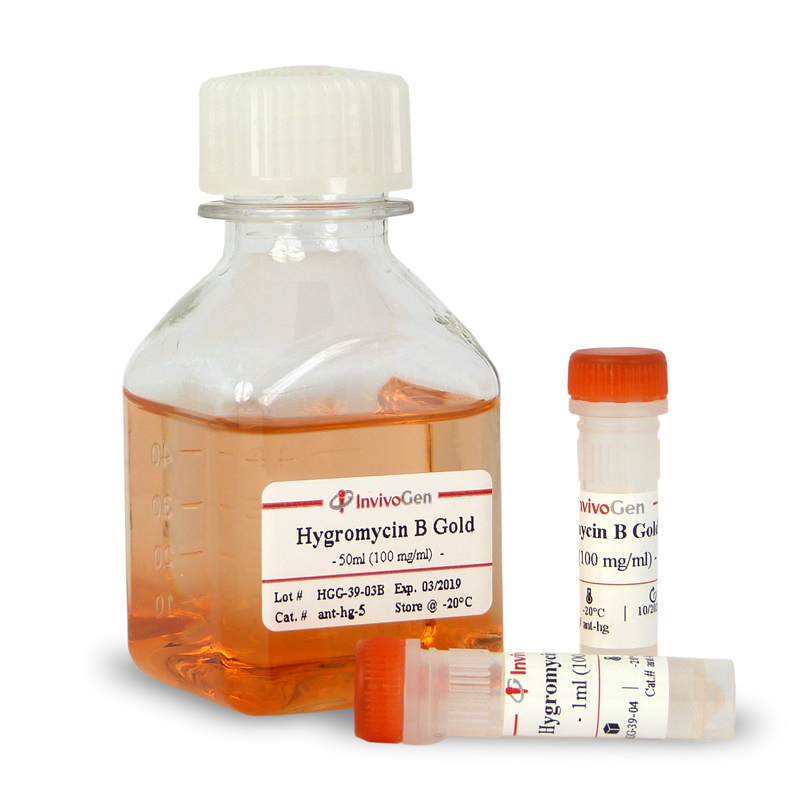Hygromycin B Gold
| Product | Unit size | Cat. code | Docs. | Qty. | Price | |
|---|---|---|---|---|---|---|
|
Hygromycin B Gold (100 mg/ml solution) Selective antibiotic for the hph gene |
Show product |
1 g (10 x 1 ml) 2 g (20 x 1 ml) 5 g (1 x 50 ml) |
ant-hg-1
|
Selection antibiotic for bacteria and mammalian cells – Sterile, endotoxin-tested
Hygromycin B Gold is an ultrapure Hygromycin B used for the selection of bacteria and eukaryotic cells, provided as a sterile, cell culture-tested solution. Hygromycin B is an aminoglycoside antibiotic produced by Streptomyces hygroscopicus, active against bacteria, fungi, and higher eukaryotic cells. It interferes with translocation [1] causing mistranslation of the 70s ribosomal subunit [2], thus inhibiting protein synthesis.
Hygromycin B is used as a selective agent on a wide variety of eukaryotic and prokaryotic cells expressing the hph resistance gene [3-5]. Due to its unusual mechanism of action, Hygromycin B can be used for dual-selection experiments. Since Hygromycin B is active in both bacteria and mammalian cell lines, vectors can be designed that carry only one drug resistance marker for selection. Selection with Hygromycin B Gold is usually achieved with concentrations ranging from 50 - 200 µg/ml in mammalian cells and 50 -100 µg/ml in bacteria.
Key features
- Each lot thoroughly tested to ensure lot-to-lot reproducibility
- Potency validated in hygromycin-sensitive and hygromycin-resistant mammalian cell lines
- Absence of long-term effects confirmed in hygromycin-resistant cells
Please click here for a protocol to facilitate the transition from using Hygromycin B to Hygromycin B Gold.
All InvivoGen products are for research use only, and not for human or veterinary use.
References:
1. Cabanas M. et al., 1978. Dual interference of Hygromycin B with ribosomal translocation and with Aminoacyl-tRNA recognition. Eur. J. Biochem. 87:21‑7.
2. Gonzales, A. et al., 1978. Studies on the mode of action of hygromycin B, an inhibitor of translocation in eukaryotes. Biochem Biophys Acta 521:459‑69.
3. Gritz L. & Davies J., 1983. Plasmid-encoded hygromycin B resistance: the sequence of hygromycin B phosphotransferase gene and its expression in Escherichia coli and Saccharomyces cerevisiae. Gene 25:179-88.
4. Cullen D. et al., 1987. Transformation of Aspergillus nidulans with the hygromycin-resistance gene, hph. Gene 57:21-6.
5. Santerre R. et al., 1984. Expression of prokaryotic genes for hygromycin B and G418 resistance as dominant-selection markers in mouse L cells. Gene 30:147-56.
Specifications
CAS number: 31282-04-9
Formula: C20H37N3O13, HCl
Molecular weight: 563.5 g/mol
Appearance (form): Liquid
Appearance (color): Colorless to light brown
Product concentration: 100 mg/ml
Buffer: HEPES
pH: 7.5 - 8.1
Purity: ≥ 90% (HPLC)
Sterility: 0.2 um filter sterilized
Endotoxin level: < 0.5 EU/mg
Working concentration: 50 -200 µg/ml (mammalian cells), 50 - 100 µg/ml (E.coli)
Quality Control: Cell-culture tested
Structure:

Contents
Hygromycin B Gold (previously named HygroGold™) is supplied as a sterile filtered solution at 100 mg/ml in HEPES buffer.
This product is available in three pack sizes:
- ant-hg-1: 10 x 1 ml (1 g)
- ant-hg-2: 20 x 1 ml (2 g)
- ant-hg-5: 1 x 50 ml (5 g)
![]() Hygromycin B Gold is shipped at room temperature.
Hygromycin B Gold is shipped at room temperature.
![]() Upon receipt, it should be stored at 4°C or -20°C.
Upon receipt, it should be stored at 4°C or -20°C.
![]() SPECIAL HANDLING: Hygromycin B is a hazardous compound. Avoid contact with skin and eyes.
SPECIAL HANDLING: Hygromycin B is a hazardous compound. Avoid contact with skin and eyes.
FAQs
In the TDS it is stated that less Hygromycin B Gold (50-100 µg/ml) can be used in low salt LB, however we only have premixed high salt LB in our lab, therefore what concentration of Hygromycin B Gold should be used for selection?
We recommend to use Hygromycin B Gold at a concentration between 100 – 150 µg/ml for high salt LB conditions.
What is the preferred storage method for Hygromycin B Gold?
Hygromycin B Gold is shipped at room temperature. Upon receipt, it can be stored at 4°C for short term storage or -20°C for long term storage.
Avoid repeated freeze-thaw cycles. The expiry date is specified on the product label.
Once opened it remains stable for 1 year at -20°C providing you avoid repeated freeze-thaw cycles, and it can be kept at 4°C for 3 months provided it is kept in sterile conditions.
What is the selection concentration of Hygromycin B Gold in mammalian cells?
The working concentration of Hygromycin B Gold in mammalian cell lines varies between 50 -200 μg/ml, with a few reported cases of up to 500 μg/ml. In an initial experiment we recommend to determine the optimal concentration of Hygromycin B Gold required to kill your host cell line. Generally, Hygromycin B Gold is used at 200 μg/ml, a 500-fold dilution of the stock solution.
For more detailed information, please refer to the technical data sheet for this product.
What is the selection concentration of Hygromycin B Gold in E. coli?
Hygromycin-resistant transformants are selected in low salt LB agar medium supplemented with 50 to 100 μg/ml Hygromycin B Gold. Plates containing Hygromycin B Gold are stable for 1 month when stored at 4 °C.






